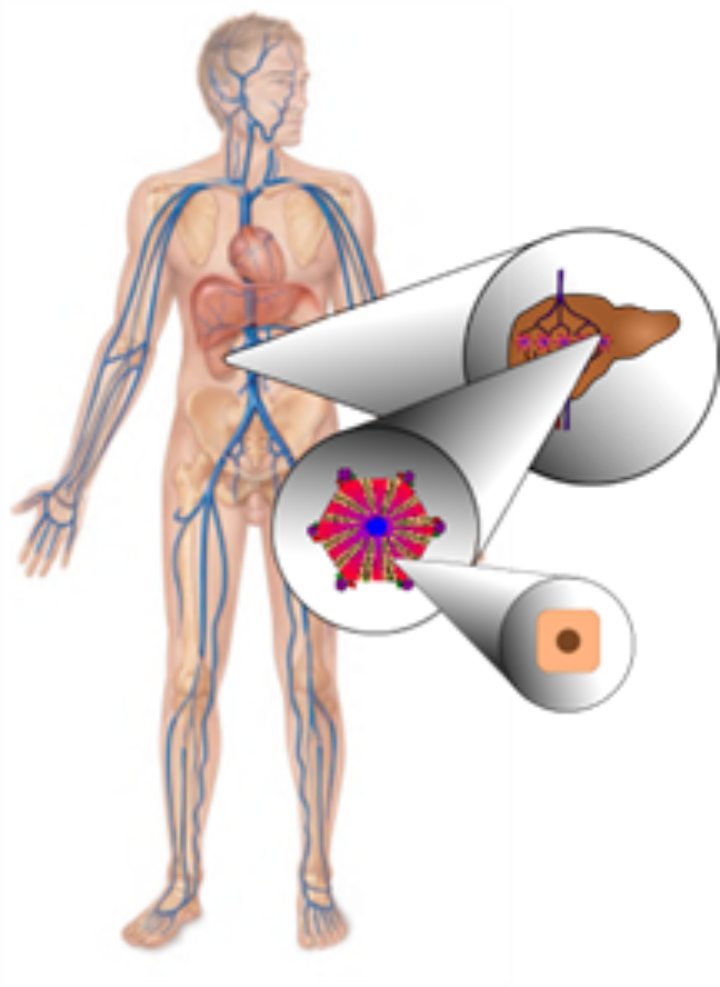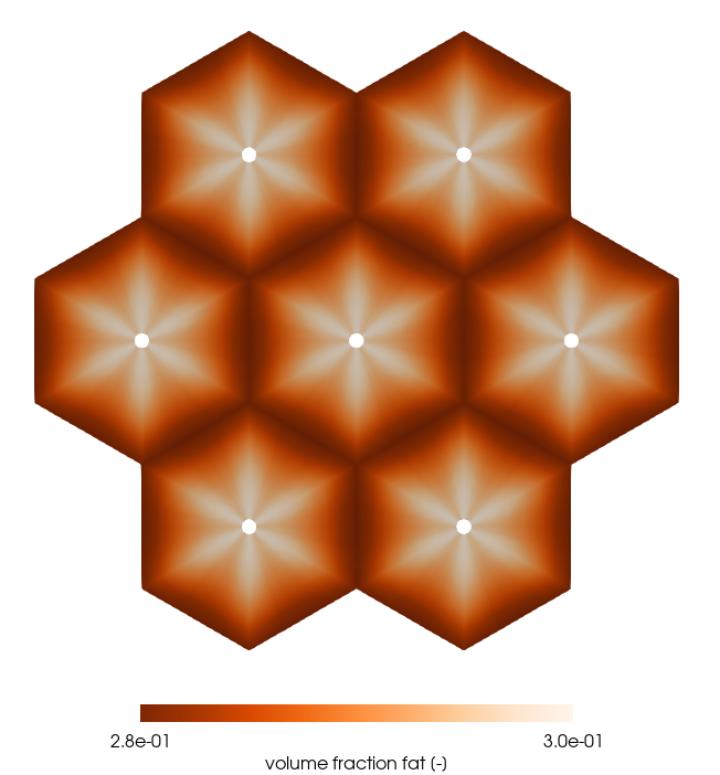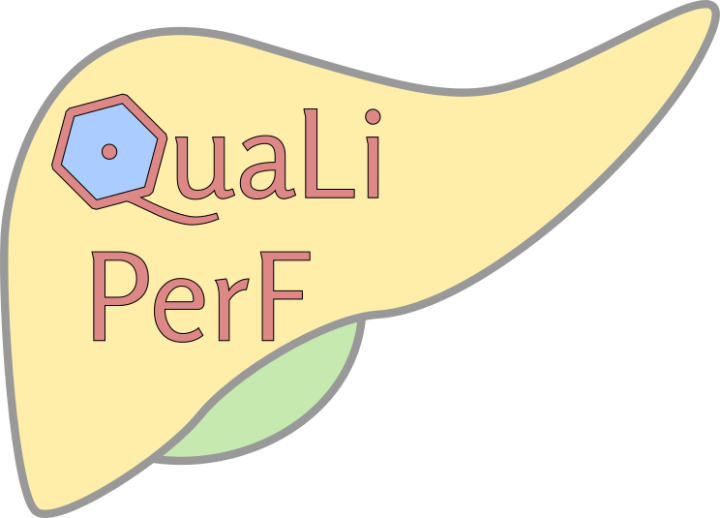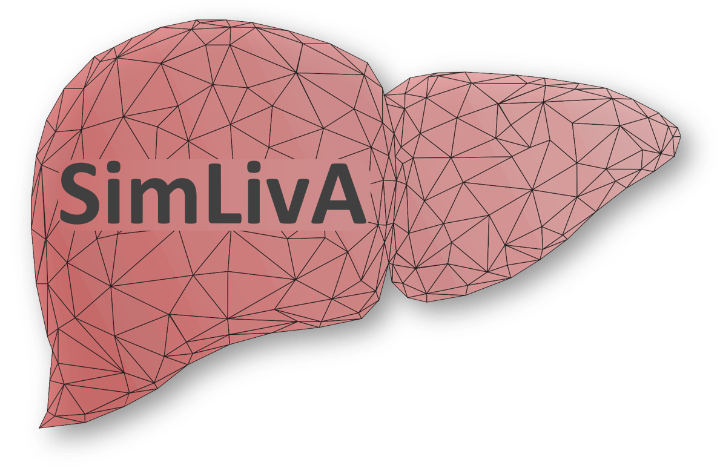The liver is the most important organ responsible for metabolic homeostasis like glucose metabolism or fat storage and the detoxification of blood. Various liver diseases like the non-alcoholic fatty liver disease (NAFLD) can affect the liver functions. Since about 20-30% of the population in industrial countries suffer from a NAFLD, which results for example from a high fat diet, a better understanding of the development of fat in the liver cells and their effects on the blood perfusion is necessary for a better diagnosis and finally an improved therapeutic treatment.
To simulate the processes in the liver, we use a multicomponent, poro-elastic, multiphasic and multiscale function-perfusion approach.
On the organ scale the total perfusion as well as the blood pressure is simulated. This affects the blood perfusion through the liver lobules on the lobule scale, where we have an anisotropic blood flow along the sinusoid, the liver cells. On the lobule scale the complex biological structure of the liver lobules is described by the Theory of Porous Media (TPM). The metabolism processes take place on the cell scale, where we use ordinary differential equations to describe the extensive procedures.
The picture on the right shows the distribution of the fat in the liver lobule, with help of the volume fraction of the fat.
The numerical model allows a non-invasive, patient-specific analysis of the liver and can help to improve therapy as well as actual surgical procedures. Furthermore, the model can help to predict the progress of a NAFLD and its effect on the liver functions like perfusion or blood pressure, as well as interaction with other liver processes like the detoxification of toxins.
This project is funded by Deutsche Forschungsgemeinschaft (DFG, German Research Foundation) under Germany´s Excellence Strategy – EXC 2075 – 390740016.
This work was supported by the German Research Foundation (DFG) within the Research Unit Programme FOR 5151 "QuaLiPerF (Quantifying Liver Perfusion–Function Relationship in Complex Resection––A Systems Medicine Approach)" by grant number 436883643
Funded by Deutsche Forschungsgemeinschaft (DFG, German Research Foundation) by grant number 465194077. (Priority Programme SPP 2311, Subproject SimLivA)
Cooperation partners
- Uta Dahmen, Uniklinikum Jena
- Olaf Dirsch, Klinikum Chemnitz
- Bruno Christ, Uniklinikum Leipzig
- Jana Schleicher, Uniklinikum Jena/FSU Jena
- Matthias König, Humboldt Universität Berlin
- Lars Ole Schwen, MEVIS Bremen
- Hans-Michael Tautenhahn, Uniklinikum Jena
- Jürgen Reichenbach, Uniklinikum Jena
- Karl-Heinz Herrmann, Uniklinikum Jena
- Manja Marz, FSU Jena
- Nicole Radde, Universität Stuttgart
Publications
Bruno Christ, Maximilian Collatz, Uta Dahmen, Karl-Heinz Herrmann, Sebastian Höpfl, Matthias König, Lena Lambers, Manja Marz, Daria Meyer, Nicole Radde, Jürgen R. Reichenbach, Tim Ricken, and Hans-Michael Tautenhahn
Hepatectomy-induced alterations in hepatic perfu-sion and function - toward multi-scale computational modeling for a better prediction of post-hepatectomy liver function. Frontiers in Physiology, 12, November 2021, 10.3389/fphys.2021.733868
Seyed M. Seyedpour, Mehdi Nabati, Lena Lambers, Sara Nafisi, Hans-Michael Tautenhahn, Ingolf Sack, Jürgen R. Reichenbach, and Tim Ricken
Application of magnetic resonance imagingin liver biomechanics: A systematic review. Frontiers in Physiology, 12, September 2021, 10.3389/fphys.2021.733393
Lena Lambers, Marlon Suditsch, Arndt Wagner, Tim Ricken
A Multiscale and Multiphase Model of Function‐Perfusion Growth Processes in the Human Liver
PAMM 20(1), 2021
Tim Ricken, Lena Lambers
On computational approaches of liver lobule function and perfusion simulation
GAMM-Mitteilungen 42 (4), 2019
Lena Lambers, Tim Ricken, Matthias König
Model Order Reduction (MOR) of Function‐Perfusion‐Growth Simulation in the Human Fatty Liver via Artificial Neural Network (ANN)
PAMM 19, 2019
Lena Lambers, Tim Ricken, Matthias König
A multiscale and multiphase model for the description of function-perfusion processes in the human liver
Advances in Engineering Materials, 2019
Tim Ricken, Navina Waschinsky, Daniel Werner
Simulation of Steatosis Zonation in Liver Lobule—A Continuummechanical Bi-Scale, Tri-Phasic, Multi-Component Approach
Biomechanical Today, 2018
Bruno Christ, Uta Dahmen, Karl-Heinz Herrmann, Matthias König, Jürgen R. Reichenbach, Tim Ricken, Jana Schleicher, Lars Ole Schwen, Sebastian Vlaic and Navina Waschinsky
Computational Modeling in Liver Surgery
Front. Physiol. 8:906., November 2017
Navina Waschinsky, Daniel Werner, Tim Ricken, Uta Dahmen, and Olaf Dirsch
On a bi-scale and tri-phasic model for the description of growth in biological tissue using the example of the human liver
PAMM _Proc. Appl. Math. Mech. 16, 109 – 110 (2016)
Daniel Werner, Tim Ricken, Uta Dahmen, Olaf Dirsch, Hermann-Georg Holzhütter and Matthias König
On the Influence of Growth in Perfusion Dependent Biological Systems - at the Example of the Human Liver
PAMM _ Proc. Appl. Math. Mech. 15, 119 – 120 (2015)

Lena Lambers
Dr.-Ing.Head of Computational Biomechanics Group, Researcher







